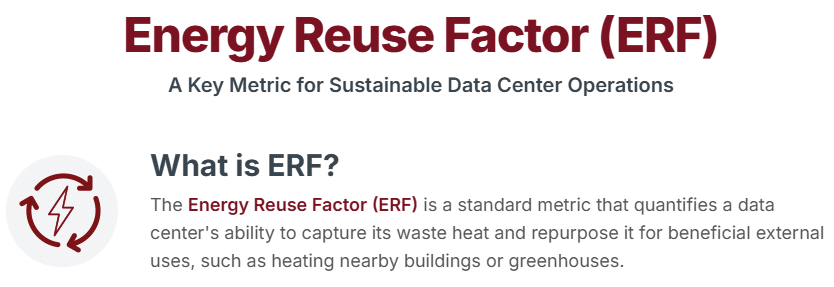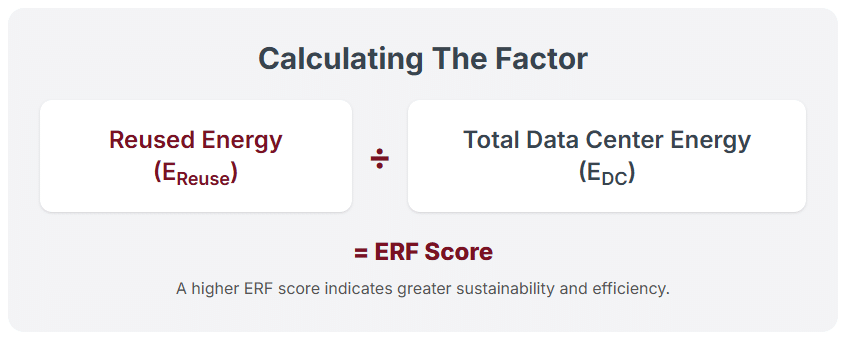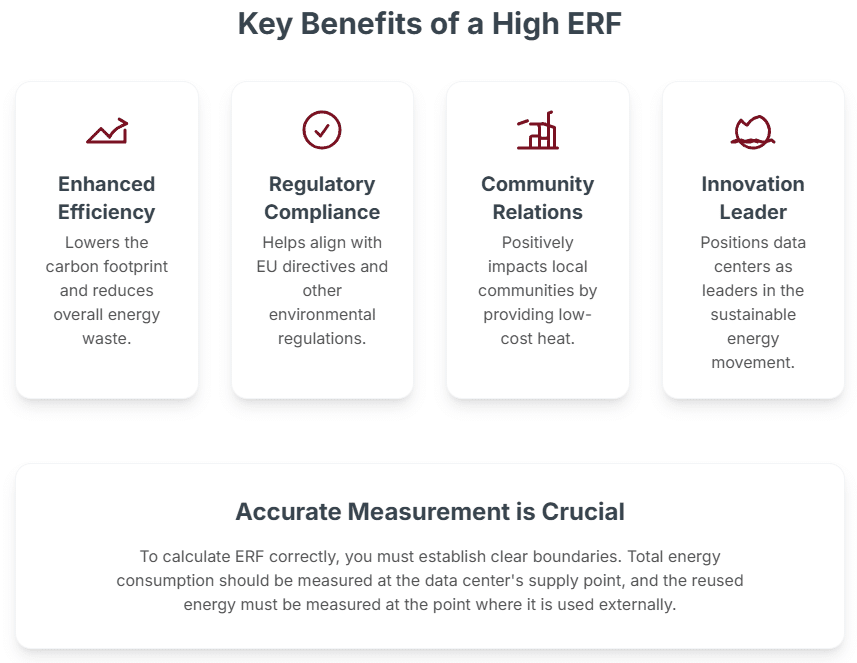Energy Reuse Factor: A Key Metric for Sustainable Data Center Operations
Published on February 23, 2024,
by
As sustainability becomes a top priority for IT operations, understanding and improving energy reuse in data centers is more critical than ever. The Energy Reuse Factor (ERF) is emerging as a key metric that not only supports environmental goals but also aligns with evolving global regulations. By capturing and repurposing waste energy, data centers can significantly reduce their carbon footprint and enhance operational efficiency.

Understanding Energy Reuse
Data centers generate substantial amounts of waste heat due to their high energy consumption, primarily from IT equipment and infrastructure supporting operations such as cooling systems, power delivery, and other utilities. Traditionally, this waste heat has been regarded as an unavoidable byproduct, often expelled into the environment with no beneficial use. However, with the increasing emphasis on sustainability, many operators are now exploring innovative ways to harness this waste heat, redirecting it for use within the data center premises, nearby facilities, or community heating projects.
The EU Directive and ISO Standard
The European Union, recognizing the potential of energy reuse in data centers, has incorporated reporting requirements on energy reuse levels into the EU Energy Efficiency Directive (EU EED). The directive references the ISO standard 50600-4-6, which introduces the Energy Reuse Factor (ERF) as a standard metric for assessing the effectiveness of energy reuse initiatives in data centers.
Defining Energy Reuse Factor (ERF)

The equation defines the ERF:
ERF = EReuse ÷ EDC
Where:
- EReuse represents the annual amount of energy from the data center utilized externally, partially or entirely, substituting energy requirements beyond the data center's boundaries.
- EDC denotes the total annual energy consumption of the data center, including IT equipment (EIT) and infrastructure necessary for power delivery, cooling, and other ancillary services.
This metric provides a straightforward yet powerful way to quantify the efficiency of energy reuse practices. A higher ERF indicates a more significant proportion of waste heat being repurposed, reflecting positively on the data center's sustainability profile.
Measurement and Application
Accurate measurement of ERF requires a clear demarcation of the data center's boundaries, with EDC measured at the point where energy is supplied to the data center, and EReuse measured where the repurposed energy is handed off for external use. This often involves sophisticated monitoring of thermal energy transfer, converting measurements like temperature increases and flow rates into equivalent energy units (kWh).
Implications for Sustainable Data Center Operation

Adopting the ERF metric offers several benefits for data center operators and the broader community:
- Enhanced Efficiency: Data centers can significantly reduce their energy consumption and carbon footprint by focusing on energy reuse.
- Regulatory Compliance: Reporting ERF aligns with EU directives, aiding data centers in meeting regulatory requirements and avoiding potential penalties.
- Community Relations: Utilizing waste heat for community heating or other local projects can improve relations and contribute positively to the local economy and environment.
- Innovation and Leadership: Pioneering energy reuse projects position data center operators as leaders in sustainability, potentially setting new industry standards.
In conclusion, the Energy Reuse Factor (ERF) emerges as a critical metric in sustainable data center operations, offering a precise measure of how effectively a facility repurposes its waste heat. As the digital economy continues to grow, and with it, the global footprint of data centers, metrics like ERF in driving environmental sustainability and efficiency cannot be overstated. By embracing energy reuse and striving for higher ERF values, data centers can play a pivotal role in mitigating their environmental impact while continuing to support the ever-expanding digital landscape.
Additional Resources
White Paper: Fundamental Measures of Data Center Sustainability
The EN 50600: How to meet the European standard for data centres (techerati.com)
Executive Brief: Climate Risk Disclosures in Data Centers - A Review of the Proposed SEC Guidelines
Executive Brief: Singapore's Data Centre Energy Efficiency Scheme (DCS)
What is PUE and how is it Calculated? | Nlyte
The Vital Role of Renewable Energy Factor in Advancing Sustainable Data Centers
